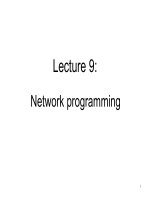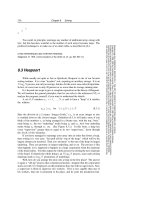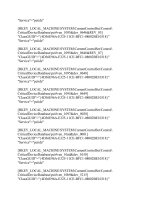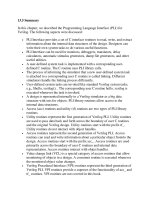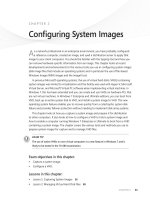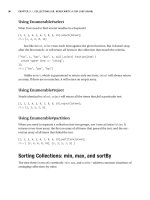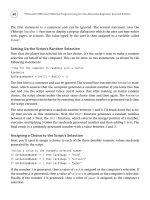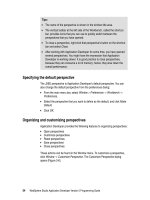CS193P - Lecture 9 ppsx
Bạn đang xem bản rút gọn của tài liệu. Xem và tải ngay bản đầy đủ của tài liệu tại đây (349.54 KB, 56 trang )
CS193P - Lecture 9
iPhone Application Development
Data in Your iPhone App
Announcements
•
Presence 2 is due on Tuesday 5/5 at 11:59pm
!
Questions?
Announcements
•
Friday optional lectures will now be recorded
!
Should become available on iTunes U if all goes well!
!
This Friday: Loren Brichter ()
Announcements
•
Final projects!
!
Groups of 1-2 people
!
Final 3 weeks of the course
!
Due Sunday 6/7 at 11:59PM
!
Presentations on Monday 6/8 from 12:15-3:15PM
•
You must send us your proposal for approval
!
Approval deadline is Monday 5/11
!
But the earlier you’re approved, the earlier you can start
•
Students retain ownership of final projects
Frequently Encountered Issues
•
“Calling a method on object X doesn’t do anything!”
!
Remember that in Objective-C, messaging nil is allowed
!
If the method has a return value, it will return zero or nil
!
Try inspecting the value of the variable with NSLog() or gdb
Frequently Encountered Issues
•
“My IBOutlet variables are nil!”
!
Remember that view controllers don’t load their NIBs right away
!
Don’t try to access IBOutlet variables in -init methods
!
Instead, use -viewDidLoad or -viewWillAppear:
!
-viewDidLoad called once after loading the view
!
-viewWillAppear: called every time the view comes onscreen
Today’s Topics
•
Data in Your iPhone App
!
Saving & loading local data
!
Accessing remote data over the Internet
Today’s Topics
•
Property Lists
•
iPhone’s File System
•
Archiving Objects
•
The Joy of SQLite
•
Web Services
•
App Data Flow
Property Lists
Property Lists
•
Convenient way to store a small amount of data
!
Arrays, dictionaries, strings, numbers, dates, raw data
!
Human-readable XML or binary format
•
NSUserDefaults class uses property lists under the hood
When Not to Use Property Lists
•
More than a few hundred KB of data
!
Loading a property list is all-or-nothing
•
Complex object graphs
•
Custom object types
Reading & Writing Property Lists
•
NSArray and NSDictionary convenience methods
•
Operate recursively
// Writing
- (BOOL)writeToFile:(NSString *)aPath atomically:(BOOL)flag;
- (BOOL)writeToURL:(NSURL *)aURL atomically:(BOOL)flag;
// Reading
- (id)initWithContentsOfFile:(NSString *)aPath;
- (id)initWithContentsOfURL:(NSURL *)aURL;
Writing an Array to Disk
NSArray *array = [NSArray arrayWithObjects:@“Foo”,
[NSNumber numberWithBool:YES],
[NSDate dateWithTimeIntervalSinceNow:60],
nil];
[array writeToFile:@“MyArray.plist” atomically:YES];
<?xml version="1.0" encoding="UTF-8"?>
<!DOCTYPE plist PUBLIC "-//Apple//DTD PLIST 1.0//EN"
" /><plist version="1.0">
<array>
! <string>Foo</string>
! <true/>
! <date>2009-04-29T15:26:18Z</date>
</array>
</plist>
Writing a Dictionary to Disk
NSDictionary *dict = [NSDictionary dictionaryWithObjectsAndKeys:
@“Name”, @“Evan”,
@“Lecture”, [NSNumber numberWithInt:9],
nil];
[dict writeToFile:@“MyDict.plist” atomically:YES];
<?xml version="1.0" encoding="UTF-8"?>
<!DOCTYPE plist PUBLIC "-//Apple//DTD PLIST 1.0//EN"
" /><plist version="1.0">
<dict>
! <key>Name</key>
! <string>Evan</string>
! <key>Lecture</key>
! <integer>10</integer>
</dict>
</plist>
NSPropertyListSerialization
•
Allows finer-grained control
!
File format
!
More descriptive errors
!
Mutability
// Property list to NSData
+ (NSData *)dataFromPropertyList:(id)plist
format:(NSPropertyListFormat)format
errorDescription:(NSString **)errorString;
// NSData to property list
+ (id)propertyListFromData:(NSData *)data
mutabilityOption:(NSPropertyListMutabilityOptions)opt
format:(NSPropertyListFormat *)format
errorDescription:(NSString **)errorString;
More on Property Lists
•
“Property List Programming Guide for Cocoa”
/>Conceptual/PropertyLists/
iPhone’s File System
Keeping Applications Separate
Image (cc) by davidsilver on Flickr
Why Keep Applications Separate?
•
Security
•
Privacy
•
Cleanup after deleting an app
Home Directory Layout
•
Each app has its own set of directories
•
<Application Home>
!
MyApp.app
!
MyApp
!
MainWindow.nib
!
SomeImage.png
!
Documents
!
Library
!
Caches
!
Preferences
•
Applications only read and write within their home directory
•
Backed up by iTunes during sync (mostly)
File Paths in Your Application
// Basic directories
NSString *homePath = NSHomeDirectory();
NSString *tmpPath = NSTemporaryDirectory();
// Documents directory
NSArray *paths =
NSSearchPathForDirectoriesInDomains(NSDocumentDirectory,
NSUserDomainMask, YES);
NSString *documentsPath = [paths objectAtIndex:0];
// <Application Home>/Documents/foo.plist
NSString *fooPath =
[documentsPath stringByAppendingPathComponent:@“foo.plist”];
Including Writable Files with Your App
•
Many applications want to include some starter data
•
But application bundles are code signed
!
You can’t modify the contents of your app bundle
•
To include a writable data file with your app
!
Build it as part of your app bundle
!
On first launch, copy it to your Documents directory
Archiving Objects
Archiving Objects
•
Next logical step from property lists
!
Include arbitrary classes
!
Complex object graphs
•
Used by Interface Builder for NIBs
Making Objects Archivable
•
Conform to the <NSCoding> protocol
// Encode an object for an archive
- (void)encodeWithCoder:(NSCoder *)coder
{
[super encodeWithCoder:coder];
[coder encodeObject:name forKey:@“Name”];
[coder encodeInteger:numberOfSides forKey:@“Sides”];
}
// Decode an object from an archive
- (id)initWithCoder:(NSCoder *)coder
{
self = [super initWithCoder:coder];
name = [[coder decodeObjectForKey:@“Name”] retain];
numberOfSides = [coder decodeIntegerForKey:@“Side”];
}
